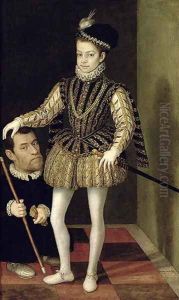Giacomo (L'Argenta) Vighi Paintings
Giacomo Vighi, also known as Giacomo da L'Argenta or simply L'Argenta, was an Italian painter from the Renaissance period. Born in 1469 in Argenta, a town in the province of Ferrara, Italy, Vighi was an important figure in the Ferrarese school of painting, which was characterized by a blend of local traditions and the influence of the wider Renaissance movement that was sweeping through Italy at the time.
Although not as widely known as some of his contemporaries, Vighi's work is an example of the transition from Gothic to Renaissance styles, showing a keen interest in the humanistic themes and the naturalistic representation of figures that were central to Renaissance art. He was likely influenced by artists such as Cosme Tura and Ercole de' Roberti who were prominent in Ferrara, as well as by the works of Andrea Mantegna.
Vighi's career took place during a period of significant cultural development in Ferrara under the patronage of the Este family. His works included religious compositions, often altarpieces, which were notable for their vivid color and attention to detail. Vighi's paintings often depicted scenes from the Bible and the lives of saints, imbued with expressive emotion and a certain degree of realism, which was becoming increasingly appreciated during this period.
The documentation about Vighi's life and career is somewhat scarce, and many of his works have been lost or remain unidentified. Nonetheless, some of his paintings have been preserved and can be found in various Italian museums and churches. Vighi's contribution to the Ferrarese school has been recognized by art historians, and his works are valued for their historical significance and artistic merit.
Giacomo Vighi passed away in 1544. Although he may not have achieved the same level of fame as some of his peers, his paintings are a testament to the rich and evolving art scene of Ferrara during the Renaissance. His legacy is reflected in the continued study and appreciation of the Ferrarese school and its unique position within the broader context of Italian Renaissance art.
